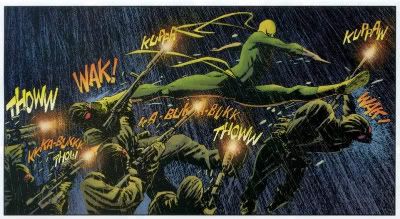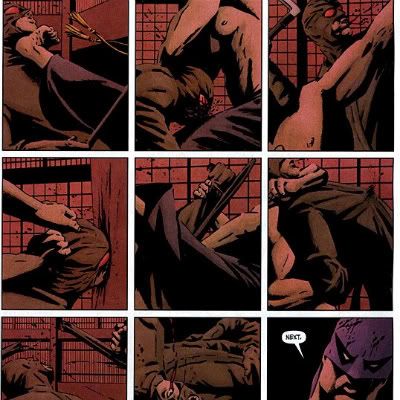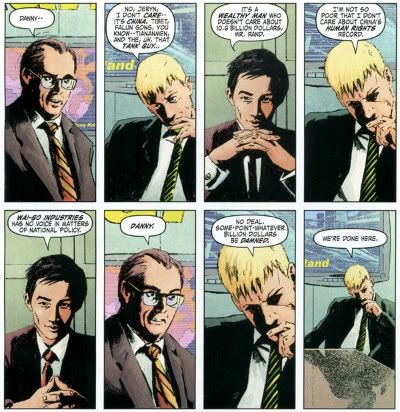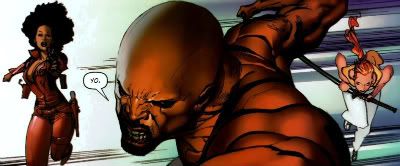
A fiery-fisted champion slicing through the bullet-strewn cityscape, weaving and chopping through a horde of green jumpsuits. A tired, scarred veteran pinwheeling through the air, blasting away concrete pillars with glowing guns. A rebel superhero naming anonymous drones with the silly titles of the well-practiced kung-fu strikes he uses to knock them down. Decades old rivals finally charging and making a second sun out of their impact. A giant wearing fat like a castle wall and wielding lightning like a whip. A pale waif whose bosom belches all the spiders you could ever imagine in the deepest hell. A green ghost raining unseen blows down on a purple-clad bully.
All good reasons to read Immortal Iron Fist.

And the story's not bad.
Well, it's not horrible. Immortal Iron Fist follows, or at least should follow, the adventures of Danny Rand. Rand won the privilege of wielding the power of the Iron Fist by defeating the dragon Shou-Lao the Undying. The book is, at its best, pure fucking kung-fu awesome.
In the beginning of his most recent ongoing series, Rand finds himself in the middle of a conspiracy involving Hydra, his old enemy Davos the Steel Serpent, ancient foes he didn't even know were his to fight, and supernatural forces he doesn't understand; and frankly that I still don't completely understand.
There's a lot of pieces to Immortal Iron Fist and when you're immersed in the book and reading it, it's just fine, but when you step back and look at it as a whole, it falls apart. A big problem is that the writers who began the series, Ed Brubaker and Matt Fraction, forgot that Iron Fist isn't Batman. Danny Rand has spent a good part of his fictional life in whatever room Marvel puts heroes like Captain Ultra and the Stuntmaster when they've become so unpopular that Captain America doesn't even bother putting them on his Evite list to fight the Beyonder or Thanos. But we get very little introduction to Danny Rand and don't really know a lot about him. Having now read all five trade paperback reprints that chronicle the series, I still don't know very much about him. I don't expect the kind of literary characterization that would send feminist theorists and Marxist theorists and the rest scrambling to submit their cultural studies profiles of the Immortal Iron Fist to whatever peer-reviewed journal would take them, but after investing three-plus years in a comic book series and - believe me, in spite of the tone of this article so far - falling head-over-heels for it, I do expect to be able to know enough to describe the guy when asked; to be able to say more than "Blond. Kung-fu. Rich. Not evil."
In spite of the fact that it was co-writer Ed Brubaker's involvement in the book that attracted me to it (he had already hooked me on Captain America and Daredevil, two books I hadn't cared about until he wrote them), artist David Aja is the reason why Immortal Iron Fist, Vol. 1: The Last Iron Fist Story is one of my most often thumbed-through graphic novels.

Before reading Immortal Iron Fist, I never understood why readers would call for the revival of martial arts books like Iron Fist and Shang-Chi. It seemed to me that the success of martial arts films depended on the viewers being able to experience the motion, speed, and skill of the actors' choreographed battles, and that the relatively static medium of comics just wouldn't serve that genre well. Now that I think back on it, I wonder why I thought this specifically about martial arts comics and not about every other kind of action comic, but no matter from where my dumb-assery sprang, David Aja cured me of it.
David Aja is the main artist for the first two volumes of the series - Immortal Iron Fist, Vol. 1: The Last Iron Fist Story and Immortal Iron Fist, Vol. 2: The Seven Capital Cities of Heaven - and his work is stunning. I lay most of what is great about Immortal Iron Fist at his doorstep. He takes the kind of action sequences that usually bore me to tears, like ones of the hero fighting overwhelming hordes of cannon fodder that never seem very suspenseful because cannon fodder is cannon fodder precisely because they suck at fighting good guys, and turn them into wonderfully dramatic superhero fun. What convinced me he may very well be the perfect superhero artist is that he does the calm exposition scenes just as involved and interesting as his action scenes. Scenes like Danny Rand and Luke Cage eating Chinese food while Rand licks his wounds or Rand's CFO Jeryn Hogarth explaining to Danny that his corporation is being gobbled up by a rival one are just as fun to flip through as scenes with Rand and Orson Randall cutting through Hydra hordes in the New York sewers or Iron Fist fighting a giant robot spider. As I said to my girlfriend as I was explaining the series to her yesterday, there are a number of pages in The Last Iron Fist Story that are pure exposition - Iron Fist jumping rooftops as his thoughts narrate - and if Marvel released a comic that was nothing but those scenes, as long as Aja was drawing it, I'd pay the stupid $4 an issue for the thing.

Besides Aja, another fun part of Immortal Iron Fist is something I think has become more standard practice at Marvel since this series. While Aja is the main artist for the first two volumes, other artists' work litter the book, in most cases to draw the many flashbacks and past sequences. Daniel Rand is not the first Iron Fist, but the most recent of 66 men and women who have enjoyed the mantle. One of the things that differentiates Immortal Iron Fist from previous treatments of the character is how deeply the writers delved into this history, and in most cases when they show us the bits and pieces of the other Iron Fists, artists other than Aja draw the scenes to more concretely separate past from present. One two-page flashback in The Last Iron Fist Story set off all my good geek alarms because they actually got the guy who drew most of the Marvel comics I remember as a little Hulkling - Sal Buscema - to draw it.
The Iron Fist history was both one of Immortal Iron Fist's selling points, and one of the things that dragged it down. Most issues (if not, in fact, every single issue) feature at least one scene from the past, either from a previous Iron Fist or chronicling the trials of Danny Rand's father Wendell Rand. The third trade paperback collection, Immortal Iron Fist, Vol. 3: The Book of the Iron Fist, is almost nothing but stories like these. They were so popular that out of the series' 27 issues; 3 forgot the present and instead were cover-to-cover tales of past Iron Fists; a fourth actually told the story of a future Iron Fist; the series spawned two one-shots - Orson Randall and the Green Mist of Death and Orson Randall and the Death Queen of California - which dealt with Rand's immediate predecessor; and the mini-series that followed Immortal Iron Fist's conclusion, Immortal Weapons, was mainly retrospective stories of Iron Fist's allies, though there was a new Iron Fist story serialized as back-ups.
Unfortunately the writers invested too heavily in Danny Rand's past and not enough in his present. If pressed I can tell you more about previous Fists like Orson Randall, Wu Ao-Shi, Bei Bang-Wen, or Li Park than I can about Danny Rand. I can't say how heavily this factored into the series' cancellation, but regardless of what influenced Marvel's bottom line it certainly helped the series' decline in quality. That isn't to say the retrospective stories aren't good, they are. They're a lot of fun and Immortal Weapons was, I thought, an excellent mini-series. I was just never given a reason to give one holy crap about the guy whose name is on the cover.
The final two volumes - Immortal Iron Fist, Vol. 4: The Mortal Iron Fist and Immortal Iron Fist, Vol. 5: Escape from the Eighth City - are not great. Brubaker and Fraction are replaced by writer Duane Swierczynski and Travel Foreman, who did quite a few of the past sequences in the first two volumes, takes over main art duties.
Foreman's art isn't very appealing for a superhero book. Particularly in The Mortal Iron Fist, he's got a lot of crazy body proportions going on that sometimes look interesting but tend to confuse things in the action sequences. He eases up on the crazy proportions in Escape from the Eighth City, but it's still not as fun or satisfying as Aja's work.

Swierczynski's writing on the book doesn't particularly stand out and he doesn't really go anywhere more interesting with Rand than Brubaker and Fraction did. He keeps the Immortal Weapons - allies Rand brought back to Earth at the end of The Seven Capital Cities of Heaven - in the series but doesn't really do anything with them. Besides Fat Cobra who gets a few funny lines, none of them really stand out from one another and no chemistry between them develops. The series ends with a sigh, with Rand and Luke Cage talking in a bar. Cage makes the empty, generic statement, "You've always thought your greatest power was in those fists of yours. But actually, it's in your heart." It's a testament to the failure that all of the series' writers share at giving us any real picture of Danny Rand that this predictable final thought is as good as anything else they could've ended it with.
Check out Immortal Iron Fist, Vol.1: The Last Iron Fist Story, Immortal Iron Fist, Vol. 2: The Seven Capital Cities of Heaven, and if you like the past sequences think about grabbing Immortal Iron Fist, Vol. 3: The Book of the Iron Fist, but leave it at that. And don't expect to become a fan of a new character, just sit back and enjoy the kung-fu.


No comments:
Post a Comment